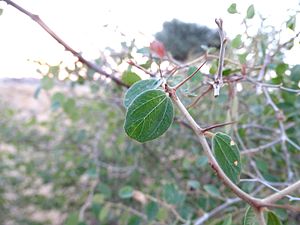Note: This is a project under development. The articles on this wiki are just being initiated and broadly incomplete. You can Help creating new pages.
Difference between revisions of "Ziziphus nummularia - Balakapriya"
(Created page with "thumb|right|''Ziziphus nummularia'', ''Balakapriya'' '''Balakapriya or Ziziphus nummularia''', also called Jharber (Hindi: झड बेर)...") |
Chaithrika (talk | contribs) |
||
| Line 14: | Line 14: | ||
*The leaves of Z. nummularia provide excellent fodder for livestock. | *The leaves of Z. nummularia provide excellent fodder for livestock. | ||
*Z. nummularia shrubs are often intercropped with millet, legumes and oil seeds. | *Z. nummularia shrubs are often intercropped with millet, legumes and oil seeds. | ||
| + | |||
| + | ==Common name== | ||
| + | |||
| + | * '''Kannada''' - ಮುಳ್ಳು ಹಣ್ಣು | ||
| + | * '''Hindi''' - Jhar Beri | ||
== References == | == References == | ||
Revision as of 10:22, 24 February 2017
Balakapriya or Ziziphus nummularia, also called Jharber (Hindi: झड बेर), is a species of Ziziphus native to the Thar Desert of western India and southeastern Pakistan and south Iran. Common names are Mulluhannu, Bhu-kartaka, Zariab,[1] etc.
Description
Ziziphus nummularia is a shrub up to 2 metres (6.6 ft) high, branching to form a thicket. The leaves are rounded like those of Ziziphus zizyphus but differ from these in having a pubescence on the adaxial surface. The plant is commonly found in agricultural fields.
Uses
- Dried fruit used medicinally as astringent in bilious affliction in India.
- The leaves are used to treat scabies and other skin diseases.
- The fruit is either eaten fresh, pickled, dried or made into confectionery. The juice can be made into a refreshing drink.
- The leaves of Z. nummularia provide excellent fodder for livestock.
- Z. nummularia shrubs are often intercropped with millet, legumes and oil seeds.
Common name
- Kannada - ಮುಳ್ಳು ಹಣ್ಣು
- Hindi - Jhar Beri
